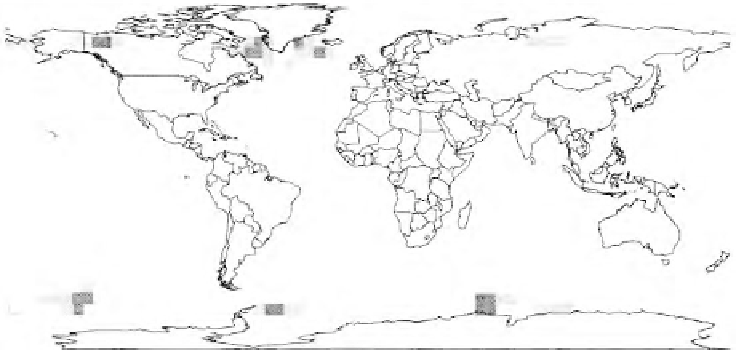Global Positioning System Reference
In-Depth Information
As shown in Figure 7.9, with all 24 GPS satellites operational, the value of
PDOP is less than 6.0 for every location and time point analyzed at 0º, 2.5º, and 5º
mask angles. Since the analysis grid is sampled every 5 minutes, there could be
occurrences where PDOP is greater than 6.0 for a period of less than 5 minutes that
would not be detected. Only with a 7.5º mask angle (or higher) does the GPS con-
stellation have outages based on PDOP exceeding 6.0.
At a 7.5º mask angle, the GPS constellation provides an availability of 99.98%.
Figure 7.10 displays the locations and durations of the outages that occur. The max-
imum outage duration is 10 minutes. The GPS constellation is designed to provide
optimal worldwide coverage. As a result, when outages do occur, they are concen-
trated in very high and very low latitudes (above 60ºN and below 60ºS).
7.4.2 Effects of Satellite Outages on GPS Availability
The previous figures have demonstrated the availability of GPS when all 24 satel-
lites are operational. However, satellites need to be taken out of service for mainte-
nance, and unscheduled outages occur from time to time. In fact, 24 satellites may
only be available 72% of the time, while 21 or more satellites are expected to be
operational at least 98% of the time [17, 38].
In order to examine the effect that a reduced constellation of satellites has on the
availability of GPS, the analysis is now repeated using the same worldwide grid, but
removing one, two, and three satellites from the nominal 24-satellite constellation.
Since a 5º mask angle is commonly used, it is the only one considered for this por-
tion of the analysis.
−
150
−
120
−
90
−
60
−
30
0
30
60
90
120
150
90
90
60
60
30
30
0
0
−
30
−
30
60
60
−
−
90
−
90
−
150
120
90
60
30
0
30
60
90
120
150
−
−
−
−
−
1- to 5-minute outages
6- to 10-minute outages
Figure 7.10
Availability of the GPS constellation (PDOP
≤
6) with a 7.5º mask angle.





Search WWH ::

Custom Search